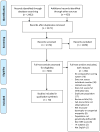Magnetic resonance imaging patterns of muscle involvement in genetic muscle diseases: a systematic review
- PMID: 27888415
- PMCID: PMC5445016
- DOI: 10.1007/s00415-016-8350-6
Magnetic resonance imaging patterns of muscle involvement in genetic muscle diseases: a systematic review
Abstract
A growing body of the literature supports the use of magnetic resonance imaging as a potential biomarker for disease severity in the hereditary myopathies. We performed a systematic review of the medical literature to evaluate patterns of fat infiltration observed in magnetic resonance imaging studies of muscular dystrophy and congenital myopathy. Searches were performed using MEDLINE, EMBASE, and grey literature databases. Studies that described fat infiltration of muscles in patients with muscular dystrophy or congenital myopathy were selected for full-length review. Data on preferentially involved or spared muscles were extracted for analysis. A total of 2172 titles and abstracts were screened, and 70 publications met our criteria for inclusion in the systematic review. There were 23 distinct genetic disorders represented in this analysis. In most studies, preferential involvement and sparing of specific muscles were reported. We conclude that magnetic resonance imaging studies can be used to identify distinct patterns of muscle involvement in the hereditary myopathies. However, larger studies and standardized methods of reporting are needed to develop imaging as a diagnostic tool in these diseases.
Keywords: Congenital myopathy; Distal myopathy; Magnetic resonance imaging; Muscular dystrophy.
Figures
References
-
- Tawil R, Padberg GW, Shaw DW, van der Maarel SM, Tapscott SJ, Participants FW. Clinical trial preparedness in facioscapulo-humeral muscular dystrophy: clinical, tissue, and imaging outcome measures 29–30 May 2015, Rochester, New York. Neuromuscul Disord NMD. 2016;26(2):181–186. doi: 10.1016/j.nmd.2015.10.005. - DOI - PubMed
Publication types
MeSH terms
Grants and funding
LinkOut - more resources
Full Text Sources
Other Literature Sources
Medical
Miscellaneous


